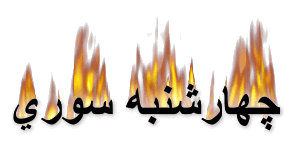|
|
|---|

| |
|---|---|
City Significance and History
... Map of Mashhad - Zoom up to street level 
History of Imam Reza's Shrine Nader Shah Mausoleum and Museum Khaje Rabi Mausoleum Who is a Mashtee?? Mashhad Image Gallery Mashhad Rugs Travel Information, Travel Agencies Mashhad Weather - Current conditions and 5 day forecast Province of Khorasan ... Khorasan News Paper Neyshabur - Hakim Omar-e-Khoyyam & Attar Ferdowsi - Hakim Abol-Ghasem Ferdowsi Toosi (940-1020 AD) Saffron - ZahFaron, The most expensive spice in the world Area Code of Cities in Iran Visitors' Opinion, Comments and FAQ | 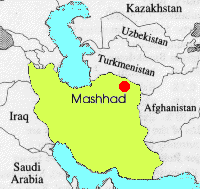
|
|
Neyshabur is located in 115 kms. west of Mashhad in the province of Khorasan. This ancient city has been the home of the great poet and mathematician Hakim Omar-e-Khayyam and the great mystical poet Attar-e Neyshaburi. In addition, Neyshabur has been a major source of Firouz-e (Turquoise) for thousands of years and still a major center of Turquoise trade.  Hakim Omar-e-Khayyam - (b. May 18, 1048, Nishapur, Iran -- d. Dec. 4, 1131, Nishapur)
Khayyam was a Persian poet, mathematician, and astronomer,
renowned in his own country and time for his scientific achievements but known to English-speaking
His work on algebra was known throughout Europe in the Middle Ages, and he also contributed to calendar reform. Cowell quotes The Calcutta Review No 59:- When the Malik Shah determined to reform the calendar, Omar was one of the eight learned men employed to do it; the result was the Jalali era (so called from Jalal-ud-din, one of the king's names) - 'a computation of time,' says Gibbon, 'which surpasses the Julian, and approaches the accuracy of the Gregorian style.'Khayyam measured the length of the year as 365.24219858156 days. Two comments on this result. Firstly it shows an incredible confidence to attempt to give the result to this degree of accuracy. We know now that the length of the years is changing in the sixth decimal place over a person's lifetime. Secondly it is outstandingly accurate. For comparison the length of the year at the end of the 19th century was 365.242196 days, while today it is 365.242190 days. In his algebra book, Khayyam refers to another work of his which is now lost. In the lost work Khayyam discusses Pascal's triangle but he was not the first to do so since the Chinese may have discussed Pascal's triangle slightly before this date. The algebra of Khayyam is geometrical, solving linear and quadratic equations by methods appearing in Euclid's Elements . Khayyam discovered a geometrical method to solve cubic equations. He did this by intersecting a parabola with a circle but, at least in part, these methods had been described by earlier authors such as Abu al-Jud. Khayyam also gave important results on ratios giving a new definition and extending Euclid's work to include the multiplication of ratios. He poses the question of whether a ratio can be regarded as a number but leaves the question unanswered. His name Khayyam ("Tentmaker") may have been derived from his father's trade. He received a good education in the sciences and philosophy in his native Neyshabur (Nishapur) and in Balkh and then went to Samarkand, where he completed an important treatise on algebra. He made such a name for himself that he was invited by the Seljuq sultan [Index] Malik-Shah to undertake the astronomical observations necessary for the reform of the calendar. He was also commissioned to build an observatory in the city of Esfahan in collaboration with other astronomers. After the death of his patron in 1092, Omar went on a pilgrimage to Mecca. Returning to Neyshabur he taught and served the court from time to time by predicting events to come. Philosophy, jurisprudence, history, mathematics, medicine, and astronomy are among the subjects mastered by this brilliant man. Unfortunately, few of his prose writings survive; these include a few brief tracts on metaphysics and a treatise on Euclid. He was in his time as famous as his contemporaries Avicenna and Hassan-e Sabah., mainly for the writing of many scientific treatises.
Hundreds of Rubaiyat are today attributed to Omar Khayyam. many are deemed apocryphal but 72 certified authentic
Rubaiyat are collected in the book The Wine of Nishapur
- Poems by Omar Khayyam.
Mausoleum of the great poet and mathematician of Iran, Hakim Omar-e-Khayyam which is situated in a beautiful garden in this town. This mausoleum was constructed in 1341 A.H. (1962 A.D.).
|

|
|
|---|
Your Opinion Counts. Check Mashhad Webpage surfers' Opinion and Comments.
Copyright © 1996-2025 FarsiNet Inc. All Rights Reserved. (090197)

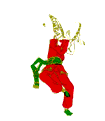
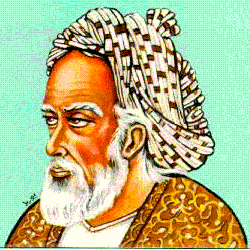 readers for his roba'iyat ("quatrains") in the version The Rubáiyát of Omar Khayyám,
published in 1859 by Edward FitzGerald (q.v.).
He discovered a geometrical method to solve cubic equations by intersecting a parabola with a circle.
readers for his roba'iyat ("quatrains") in the version The Rubáiyát of Omar Khayyám,
published in 1859 by Edward FitzGerald (q.v.).
He discovered a geometrical method to solve cubic equations by intersecting a parabola with a circle.
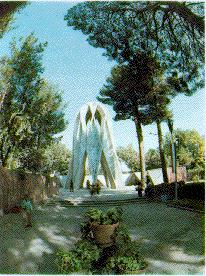
 Khayam Related Web Sites
Khayam Related Web Sites